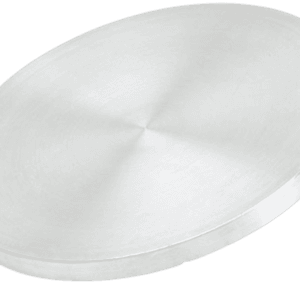Molybdenum Aluminium (Mo/Al) Sputtering Target
Introduction
Molybdenum Aluminium (Mo/Al) Sputtering Target is a high-performance composite material developed for thin film deposition in semiconductors, displays, solar cells, and advanced electronics. By combining molybdenum’s excellent electrical conductivity and high melting point with aluminium’s lightweight, corrosion-resistant properties, this target delivers stable sputtering behavior and thin films with tailored mechanical and electrical properties.
Detailed Description
Mo/Al sputtering targets are fabricated using high-purity molybdenum and aluminium, processed through vacuum melting or powder metallurgy to ensure dense, homogeneous microstructures. The combination of metals enables controlled film composition, adjustable resistivity, and enhanced adhesion properties.
Composition: Standard ratios include Mo:Al = 90:10 or 80:20 (wt%), with custom compositions available on request.
Purity: Available at 99.9% and higher to reduce contamination and improve device reliability.
Dimensions: Supplied as circular targets (25–300 mm) or rectangular plates, thicknesses 3–6 mm, customized for compatibility with various sputtering systems.
Bonding: Indium or elastomer bonding to copper/titanium backing plates ensures efficient heat transfer and longer target lifetime.
Microstructure: Fine-grain, dense materials minimize arcing and enable stable deposition.
Applications
Mo/Al sputtering targets are widely applied in:
Semiconductors – Conductive and barrier layers in integrated circuits.
Thin Film Transistors (TFT-LCD, OLED) – Electrodes and wiring layers.
Photovoltaics – Back contact layers in thin film solar cells.
Optical Coatings – Reflective and protective coatings in advanced optics.
R&D – Experimental thin films for materials science and next-generation electronics.
Technical Parameters
| Parameter | Typical Value / Range | Importance |
|---|---|---|
| Purity | ≥ 99.9% | Ensures minimal contamination in thin films |
| Diameter | 25 – 300 mm (custom) | Fits most commercial sputtering systems |
| Thickness | 3 – 6 mm | Affects sputtering efficiency |
| Bonding | Copper / Titanium backing | Improves thermal and mechanical stability |
| Mo:Al Composition | 90:10, 80:20, or custom | Enables tuning of electrical/optical properties |
Comparison with Related Materials
| Material | Key Advantage | Typical Application |
|---|---|---|
| Mo/Al Alloy Target | Balanced conductivity & corrosion resistance | TFT, semiconductors |
| Pure Molybdenum Target | High conductivity, high melting point | Microelectronics, solar cells |
| Pure Aluminium Target | Lightweight, corrosion resistance | Optical & decorative coatings |
FAQ
| Question | Answer |
|---|---|
| Can the Mo:Al ratio be customized? | Yes, compositions can be tailored to meet specific film requirements. |
| What is the lead time? | Typically 2–3 weeks, depending on specifications. |
| Do you offer bonding services? | Yes, indium or elastomer bonding with Cu/Ti backing plates is available. |
| How are targets packaged? | Vacuum-sealed, cushioned with protective foam, and shipped in export-safe cartons or wooden crates. |
| Which industries use Mo/Al targets most? | Semiconductors, display technologies, solar energy, and advanced R&D. |
Packaging
Each Molybdenum Aluminium Sputtering Target is vacuum-sealed to protect against oxidation and moisture. They are externally labeled for traceability and securely packed with foam inserts inside export-grade cartons or wooden crates to ensure safe delivery.
Conclusion
Molybdenum Aluminium (Mo/Al) Sputtering Targets combine the thermal stability of molybdenum with the lightweight, corrosion-resistant characteristics of aluminium, making them ideal for thin film deposition in electronics, displays, and photovoltaics. With high purity, customizable compositions, and strong deposition stability, they provide a dependable solution for both industrial and research applications.
For detailed specifications and a quotation, please contact us at [sales@thinfilmmaterials.com].





Reviews
There are no reviews yet.